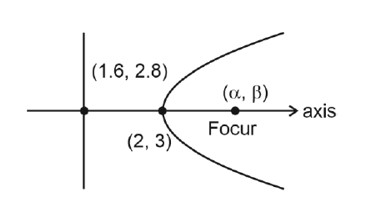For
, let the curves
and
ay intersect at origin
and a point
. Let the line
intersect the chord
and the
- axis at points
and
, respectively. If the line
bisects the area bounded by the curves,
and , and the area of
, then 'a' satisfies the equation:
For , let the curves and ay intersect at origin and a point . Let the line intersect the chord and the - axis at points and , respectively. If the line bisects the area bounded by the curves, and , and the area of , then 'a' satisfies the equation:
Option 1 -
Option 2 -
Option 3 -
Option 4 -
-
1 Answer
-
Correct Option - 2
Detailed Solution:∫? (√ax - x²/a)dx = a²/6
⇒ (2/3)√a b^ (3/2) - b³/3a = a²/6
also area of ΔOQR = 1/2
(1/2)b² = 1/2 ⇒ b=1
Put in (i) ⇒ 4a√a - 2 = a³ ⇒ a? - 12a³ + 4 = 0
Similar Questions for you
ae = 2b
Or 4 (1 – e2) = e2
4 = 5e2 ->
If two circles intersect at two distinct points
->|r1 – r2| < C1C2 < r1 + r2
| r – 2| < < r + 2
|r – 2| < 5 and r + 2 > 5
–5 < r 2 < 5 r > 3 … (2)
–3 < r < 7 (1)
From (1) and (2)
3 < r < 7
x2 – y2 cosec2q = 5
x2 cosec2q + y2 = 5
and
->
1 + sin2q = 7 – 7 sin2q
->8sin2q = 6
->
->

Slope of axis =
⇒ 2y – 6 = x – 2
⇒ 2y – x – 4 = 0
2x + y – 6 = 0
4x + 2y – 12 = 0
α + 1.6 = 4 ⇒ α = 2.4
β + 2.8 = 6 ⇒ β = 3.2
Ellipse passes through (2.4, 3.2)
⇒
&
Taking an Exam? Selecting a College?
Get authentic answers from experts, students and alumni that you won't find anywhere else
Sign Up on ShikshaOn Shiksha, get access to
- 65k Colleges
- 1.2k Exams
- 679k Reviews
- 1800k Answers
